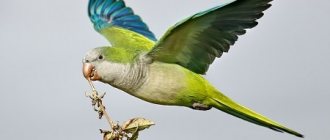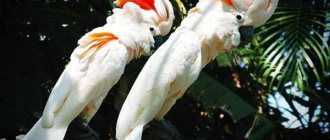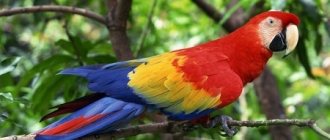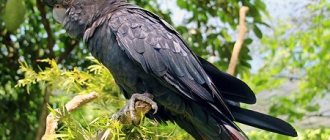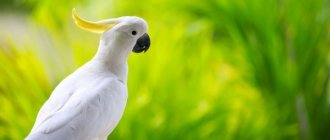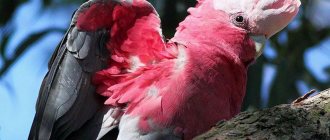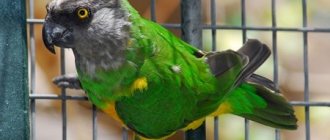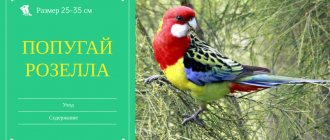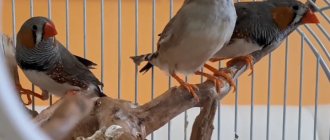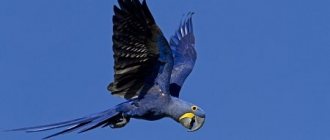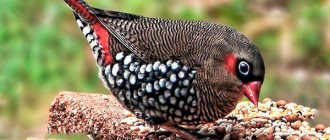Many people dream of a pet like a large yellow-crested cockatoo, but not everyone dares to have one at home. This luxurious bird feels so comfortable and free next to a person that it does not limit its behavior at all. It is difficult to raise and maintain a capricious cockatoo - few people can tame it; It is also very difficult to maintain cleanliness in an apartment where a large parrot lives. But, no matter how difficult it is to care for a white parrot with a golden “crown,” it is simply impossible to refuse such an exotic pet. After reading the article, you will learn what a yellow-crested cockatoo looks like and what kind of lifestyle it leads, what it can hurt, where to buy it and how to provide proper care at home.
Appearance
Yellow-crested cockatoos, despite their large size, have a small head. Body length - from 48 to 55 cm, length - from 30 to 40 cm, weight - 800-1000 g.
The head has a yellow crest, which consists of narrow feathers. Near the eyes there are light gray areas not covered with feathers. The iris of the eyes in males is black, in females it is brown. The legs and beak are black and gray.
The feathers are round in shape, the color of the feathers is white with a slight yellowish tint. The bottom of the tail and wings are bright yellow. The neck and plumage on the cheeks are also lemon-colored.
Species diversity
Photos show the variety of shapes and colors within the genera. Black - a large gloomy bird with a huge crest and red cheeks looks ominous, and its behavior is wild and independent. Mourning cockatoos are not very popular among lovers of tropical birds due to their discreet gray plumage and inconspicuous crest, so the most popular in home keeping remain:
- White cockatoo
A large white parrot with a tuft is the most sociable and talkative, a restless screamer and trickster. He remembers few words, but reproduces them clearly and willingly. Considered the most trainable.
- Helmet-bearing
Helmet-bearing is a motley gray-white beauty with a bright red head. Not too talkative, but very nice.
- White-tailed (mourning)
White-tailed (mourning) is an aristocratic creature with inimitable artistry. Snow-white plumage and a long crest give it a respectable appearance.
- Yellow-crested
Yellow-crested - a large (up to 1 kg) white merry fellow with a lemon crest, is also among the excellent students in training and imitating sounds.
- Pink (gala)
Gala or pink is a delicate, medium-sized (35 cm), beautiful bird in a light gray “tuxedo”. The chest, belly and cheeks are crimson in color.
- Inka
Cockatoo Inka is an unusually spectacular white parrot with a pastel pink head, neck, chest and abdomen and a stunningly colored crest reminiscent of the headdress of ancient Indians. Unfortunately, the export of this bird outside of Australia is prohibited.
- Moluccan
Moluccan - pale pink, with orange ripples, medium size (800 g). He hardly speaks, but he looks very smart.
- Corella
Corella is the smallest (300g) and affordable. The plumage is motley-gray with waves and streaks, white or yellowish. An indispensable attribute is a lemon-yellow head and orange “blush” on the cheeks. Doesn't speak at all, but is very affectionate towards his owner. Communicates with a shrill whistle.
Greater yellow-crested cockatoo
There are 4 subspecies of the Greater Yellow-crested Cockatoo:
- Cacatua galerita fitzroyi.
- Cacatua galerita galerita.
- Cacatua galerita triton.
- Cacatua galerita eleonora.
The length of this bird is from 45 to 55 cm, the wings are 25-35 cm long. The feathers that cover the ears are light yellow. Their lifespan is about 55 years. The Greater Yellow-crested Cockatoo is easy to train and quickly bonds with humans. They are able to learn a few words and scream quite loudly if they don’t like something.
Where to buy and for how much
The cost of a yellow-crested cockatoo depends on the place of purchase: on private advertisement sites you can most often see the amount of 50,000-80,000 rubles per bird. You can buy a foster chick in a nursery for a price of 100,000 rubles. If you order a bird from a European nursery, you will also have to pay for delivery. The parrot will be brought with all the necessary documents, and will also be provided with information support at the adaptation stage.
A large breed of talking parrot is an expensive pleasure. Considerable purchase costs are just the tip of the iceberg of future expenses. However, it is not even the breeder’s solvency that is decisive, but his internal qualities. Without a great love for birds, you shouldn’t get a parrot with a complex character, and the yellow-crested cockatoo is just like that - wayward, and sometimes even vindictive. It is difficult to get along with him, but very interesting and informative.
Lesser yellow-crested cockatoo
The species of lesser yellow-crested cockatoo includes 4 subspecies:
- Cacatua sulphurea abbotti.
- Cacatua sulphurea citrinocrist (orange-crested).
- Cacatua sulphurea parvula.
- Cacatua sulphurea sulphurea.
The body length of the small yellow-crested cockatoo is from 33 to 38 cm, the wings are 21-27 cm, the feathers that cover the ears are bright yellow. The average lifespan of the Lesser Yellow-crested Cockatoo is 45 years. They are difficult to learn to talk, but are well trained and can perform in circus performances.
The voice of the lesser yellow-crested cockatoo is rough, even croaking, and quickly turns into a squeal. The color of the crest can be yellow or orange.
www.zoo-ekzo.ru – Exotic animals
Lesser yellow-crested cockatoo, or yellow-cheeked cockatoo (Cacatua sulphurea, or Plyctolophus sulphurea)
Class - Birds
Order - Parrots
Family – Cockatoo
Subfamily – White cockatoos
Genus – Cockatoo
Subspecies:
1. Nominal subspecies (Cacatua sulphurea sulphurea) - up to 38 cm,
2. Timor Cockatoo (Cacatua sulphurea parvula) - Similar to the nominate subspecies, but the feathers covering the ear openings (the ear patch) are a paler yellow. Females and juveniles are characterized by the same differences as the nominate subspecies, up to 33 cm,
3. Abbott's Cockatoo (Cacatua sulphurea abbotti) Resembles the nominate subspecies, but the ear patch is pale yellow and the bird is larger in size. This is the largest lesser yellow-crested cockatoo of all its 4 subspecies. Females and young parrots are characterized similarly to the nominal subspecies, up to 40 cm,
4. Citron Cockatoo or Orange-crested Cockatoo (Cacatua sulphurea citrinocristata) Resembles the nominate subspecies of the Lesser Yellow-crested Cockatoo, but is larger in size, although not as large as the previous subspecies, Cacatua sulphurea abbotti. In addition, the Lesser Yellow-crested Citron Cockatoo has orange ear patches and crest feathers. Females and young parrots are similar in differences to the nominal subspecies, up to 38 cm.
Appearance
Body length up to 40 cm. The plumage is white, the upper part of the crest and ear area are orange. The inner side of the flight and tail feathers is yellow. The beak and paws are gray-black. The periorbital ring is without feathers, bluish in color. The coloring of males and females is the same. Males have a larger beak and head. But the main distinguishing sexual characteristic is the color of the iris. In females it is red-brown, and in males it is almost black. The voice is loud, hoarse. When frightened, sharp, turning into a squeal.
Habitat
Lives in Indonesia (Sunda Islands, Sulawesi Island). They inhabit forests, hills, forest edges, bushes, agricultural lands, monsoon forests, semi-arid areas, up to an altitude of 1200 m above sea level.
In nature
They live in pairs or small flocks of up to 10-20 individuals. They spend the night in the forest. At dawn they fly to feed. They are most active early in the morning and late in the afternoon. They drink by scooping up water with the beak. They feed both on the ground and in trees. They feed on fruits (mango, papaya, bananas, guavas, Indian dates), seeds, nuts, berries, flowers (mango, coconuts), buds, insects and their larvae, grains, green coconuts. Rice and corn crops are destroyed.
Reproduction
Nests are made in tree hollows, at a height of 10 m. There are 2-3 eggs in a clutch. Both parents hatch the eggs. The chicks hatch after 4 weeks, fledge and fly out of the nest at approximately 2 months of age.
Captivity
Cockatoos are kept in metal cages or enclosures with horizontal bars (4 mm in diameter, the distance between the bars is no more than 2-2.5 cm), with reliable locks; it is better to make the top of the cage and enclosure dome-shaped. Any material that absorbs moisture well is placed at the bottom of the cage.
The minimum cage size is 70x70x100 cm. A wooden sleeping house (30x30x100 cm, with an internal diameter of 25-35 cm) is placed inside the enclosure.
The water bowl and feeder are cleaned daily. Perches and toys are washed as they become dirty. The cage is washed and disinfected once a week, the enclosure once a month. Complete disinfection of the enclosure is carried out twice a year. The floor in the enclosure is cleaned twice a week, the bottom of the cage is cleaned daily. Household items (feeders, toys, perches, etc.) are replaced when they become unusable.
The minimum temperature at night is 10'C.
The cage must always have branches of fruit trees or eucalyptus, as well as a pond, because Cockatoos love to bathe every day. You can spray birds with a spray bottle.
The cage should have less than two perches (diameter 26-45 mm, depending on the size of the cockatoo), placed at different heights. One perch should be placed near the feeder and water, but not above it. As well as ropes, ladders, bamboo rings, a house for sleeping, three stable feeders (steel or ceramic).
The cockatoo's diet includes: seeds (sunflower, pumpkin, millet, hemp, safflower, oats, wheat, grass, pine nuts, canary seed); greens (shoots of trees, shrubs, grass, sprouted grains, lettuce, dandelion leaves, celery, mustard greens, turnip tops, chard); vegetables (milk corn, carrots, broccoli, beets, green peas and beans, cucumbers, peppers); fruits: (apples, citrus fruits, cherries, grapes, pears, plums, bananas, peaches, pomegranate, papaya, mango, strawberries); other (cottage cheese, cheese, boiled eggs, canned dog food, soft bones, chicken meat, mealworm larvae). The tubers are boiled for 30 minutes, allowed to cool, and then cut into small pieces.
Do not give: cabbage, coffee, avocado, chocolate, parsley, alcohol, sugar, dairy products (except yogurt), salt, fried foods.
Adult parrots are fed 1-2 times a day.
Fresh water should always be poured. The bowl of water should be heavy and stable. The water is changed as it gets dirty.
Birds are offered lime, eggshells, white chalk, and cuttlefish shells as additional calcium.
At first, the cockatoo will be shy and distrustful, but as it acclimatizes, it will become calm and trusting. Perfectly amenable to taming and training. Requires a lot of attention (at least two hours a day). With a lack of communication, he attracts attention to himself by constant screaming or self-plucking.
He loves to play, climb, stomp, swing; constant physical and mental stress is required.
It is necessary to provide a large number of different toys - ropes, ladders, bells, various perches, paper bags, boxes, tree branches, etc.
Use toys made only for large parrots. Once a week, toys are replaced with new ones.
When leaving, leave the radio or TV on.
Never leave small children or cockatoos alone outside their cage! Some individuals can be very jealous
The voice is quiet, screams mainly in the early morning and evening.
Breeding:
Preparation: the pair is isolated from the rest of the birds. It is not recommended to allow wild-caught birds under three years of age to breed, and captive-bred birds under 6-8 years of age. Breeding period: spring and autumn. Many male cockatoos become very aggressive during the breeding season. To reduce aggressiveness, their wings are clipped, and the nesting house is made with two entrances. The nest house should be made of multi-layer plywood or wood from 30x30x100 cm, the entrance is 25 cm, a layer of sawdust is poured on the bottom, the humidity inside is not lower than 80%.
The incubation period for eggs is 28 days. The chicks are fed by their parents. Weaning from parents occurs at 9-10 weeks of age.
In captivity they live up to 40 years.
Life in freedom
The yellow cockatoo likes to live in flocks of up to 30 birds. At the same time, they sleep on the tops of trees. They are most active early in the morning or late in the evening.
During the day, yellow cockatoos look for food in trees, rarely on the ground. On trees they gather in large flocks, where they eat pine nuts, buds, flowers, various insects, etc. On the ground they feed on plant roots.
The voice of yellow-crested cockatoo parrots is quite loud and shrill. They may scream when flying or when very scared. Their cry can be heard over vast distances. You may also hear a whistling or gurgling sound. The lifespan of parrots is from 60 to 80 years.
Lifestyle in nature
These birds live in pairs or small flocks of 10 to 30 individuals, preferring open forest spaces. They are difficult to see in the treetops, but easy to spot during flight; they fly quickly and, as a rule, accompany their flight with a loud cry. They visit fields and human lands with great frequency and destroy crops, for which many in Australia consider them pests.
Large sulphur-crests live in New Guinea, Australia, Tasmania, and small ones inhabit the Sunda Islands (Indonesia) and Sulawesi.
Content
Yellow cockatoos must be kept in cages or covered enclosures. The cage must be made more than 70 cm wide and 100 cm high. The cage should have a house for sleeping (also 1 m high and 40 cm wide). Also provide your pet with entertainment - crossbars, ladders, rings.
Drinking water must be changed every day, and once a week the cage and its contents must be thoroughly washed and disinfected.
It is interesting that for these birds the optimal daytime temperature should be like in a room, and the nighttime temperature should be +5o. They have enough natural light.
Organize a bath of water in the cage, since they love to wash themselves, you can also spray the parrots with a spray bottle.
Pay attention to birds for more than 2 hours a day, otherwise they will constantly scream or pluck their feathers to attract your attention.
These birds love to play, so they need physical and mental exercise every day. In addition, they have a good memory, and in some cases they can take revenge on someone who once offended them.
To prevent them from getting bored, it is better to keep them in pairs.
Poultry farming[edit]
Sulfur-crested cockatoos can no longer be imported into the United States under the Wild Bird Conservation Act (WBCA). [11] However, they were bred in captivity. They are socially demanding pets and have a natural desire to chew wood and other hard and organic materials. They are also loud, often making loud screams or high-pitched squeals. They can also make aggressive, unpredictable movements that can frighten people and animals, unaware of the attachment involved.
One cockatoo named Fred was still alive in 2014 at the age of 100 years. [12] Cokie Bennett of Tom Ugly's Point in Sydney was a famous sulfur-crested cockatoo that reached ages of 100 years or more. He lost his feathers, was naked for most of his life, and died in the early twentieth century. His body was stuffed and preserved after death. [13] Another "self-confident", born in 1921 and living in Arncliffe with his owner Charlie Knighton, was 76 years old in the late 1990s. [4]
Sulphur-crested cockatoos, like many other parrots, are susceptible to psittacine beak and feather disease, a viral disease that causes birds to lose their feathers and develop grotesque beaks. The disease occurs naturally in the wild [14] and in captivity. [15]
Nutrition
Yellow-crested cockatoos love sunflower seeds, millet, pumpkin seeds, oats, wheat, nuts, and millet. You can give beets, grapes, soft corn, legumes, carrots, cucumbers, red peppers, and various fruits. The poultry menu must include greens (lettuce, dandelion). You can sometimes add food of animal origin to the menu - small fish bones, cottage cheese, boiled eggs, etc.
Yellow cockatoos should never be released if there are small rodents in the house, as they can kill them.
You should not feed birds chocolate products, parsley, avocados, sugar, salty and fried foods.
The bird will consider raisins, bananas, walnuts and almonds as treats.
The parrot needs to be fed 2 times a day, and breakfast should be at 6 a.m.
Diseases and prevention
Yellow-crested cockatoos are susceptible to infectious, parasitic, and fungal diseases. They are often worried about digestive disorders, inflammation of the joints, and calluses on their paws.
Common diseases of large yellow-crested parrots living at home:
- goiter inflammation;
- intestinal disorders;
- feather mite;
- fungus of the beak, claws or skin of the feet;
- colds;
- avitaminosis;
- respiratory tract infections.
Yellow-crested cockatoos, being extremely social birds, often get sick from lack of attention. These ailments can be classified as psychological spectrum disorders. From depression, the parrot begins to pluck feathers, peck at the body - deliberately causing pain to itself. In an advanced state, the disease cannot be treated, new feathers stop growing - the bird becomes disabled.
Disease prevention involves proper care of your pet, regular examinations, and timely treatment. A minor injury is easier to treat before the situation gets worse. Monitor your parrot and immediately contact an ornithologist at the first signs of illness.
Reproduction
The mating season for birds in the southern part of Australia begins in September and ends in January, in the northern regions - May-September, in Guinea - August-February.
Yellow-crested cockatoos nest in tree hollows, most often eucalyptus, which grows near bodies of water. The nest can be located at a height of 3.5-30 meters, or can be placed in the crevices of cliffs. At night, only the female incubates the eggs, and during the day they alternate. During the nesting period, the male opens his tail and moves closer to the female, shaking his head. If she accepts his advances, a pair is formed, ready to mate. Hatching of eggs lasts 30 days. The chicks fly out of the nest at approximately 70 days, but remain near their parents for another year.
Intelligence and habits
Features of the character and behavior of yellow-crested cockatoos:
- Sociable birds with good organization within the flock. They know how to shout to warn each other about danger and call each other to a feast. They control the situation while the rest of the flock feeds.
- The developed speech apparatus allows the parrot to make various sounds and even imitate human speech. However, this species of parrot is considered difficult to train. In order for your pet to master several phrases, you need to spend a lot of time and effort training it.
- Smart, inquisitive birds can perform tricks and perform magic tricks. Large yellow-crested cockatoos often take part in circus performances.
- The wayward parrot is distinguished by demonstrative behavior. He shows his dissatisfaction with daring antics: throwing food out of the container, tearing up the soil in flower pots, throwing things off their places.
- If a cockatoo is not raised properly, it will never learn boundaries. A parrot's aggression can be directed at the owner and other people - an angry bird will attack everyone, beat with its wings, and bite wherever necessary.
- The yellow-crested cockatoo is prone to self-plucking. During periods of loneliness, he cannot occupy himself, so he experiences auto-aggression - plucking feathers, pecking at the body.
Cockatoos of any species, but especially yellow-crested cockatoos, need attention. They need affection, communication, and spending time with the owner. If you don't have time for a pet, get him a companion. Keeping cockatoos in pairs solves the problem of lack of communication.
